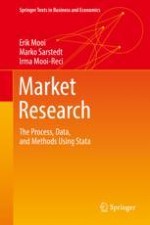2018 | OriginalPaper | Buchkapitel
9. Cluster Analysis
verfasst von : Erik Mooi, Marko Sarstedt, Irma Mooi-Reci
Erschienen in: Market Research
Verlag: Springer Singapore
Aktivieren Sie unsere intelligente Suche, um passende Fachinhalte oder Patente zu finden.
Wählen Sie Textabschnitte aus um mit Künstlicher Intelligenz passenden Patente zu finden. powered by
Markieren Sie Textabschnitte, um KI-gestützt weitere passende Inhalte zu finden. powered by

 Web Appendix (→Downloads), we offer a Stata.ado file to calculate the
Web Appendix (→Downloads), we offer a Stata.ado file to calculate the